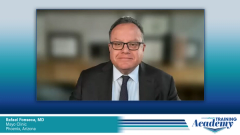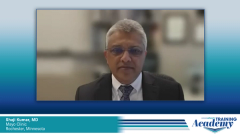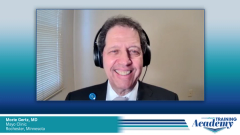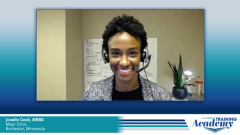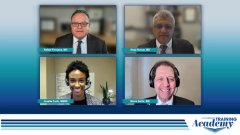
Other Bispecifics in Development for Multiple Myeloma
Before closing out the panel’s review of clinical data behind bispecifics in relapsed/refractory multiple myeloma, Morie Gertz, MD, highlights use of cevostamab therapy in this setting.
Episodes in this series

Transcript:
Rafael Fonseca, MD: So, to talk about yet another target, I’ll pass it on to Dr Gertz, who’s going to tell us about cevostamab.
Morie Gertz, MD: Thank you. So again, we have 3 approved immunotherapies, ide-cel [idecabtagene vicleucel], cilta-cel [ciltacabtagene autoleucel], and teclistamab, but they’re all targeting against BCMA [B-cell maturation antigen]. And as you mentioned, talquetamab is GPRC5D [G protein-coupled receptor, family C, group 5, member D]. But cevostamab is looking at another unique antigen, FcRH5 [Fc receptor-homolog 5], ubiquitous on plasma cells, and it also targets against CD3. One of the really remarkable aspects of this is it only requires administration every 3 weeks. And as trials have been designed, it’s not treatment to progression, it’s treatment for 1 year, and then patients can actually have a treatment-free interval. In the first update of the 160 patients enrolled in the phase 1 trial that was presented at ASH [American Society of Hematology] 2021, 45% achieved an objective response. But we still haven’t figured out exactly the best optimal way to give it because, again, grade 3 infections were seen in 19% of patients and neutropenia in 36% of patients. So, there are some issues in terms of really optimizing therapy. The recommendation currently is 17 cycles every 3 weeks; so, you get 51 weeks and then you’re done. But a super interesting subset was reported at ASH 2022, and that was those patients who completed therapy, went off therapy, and then were observed unmaintained. Now, of the 160, only 16 were reported as meeting a year that had completed all 17 cycles; 11 patients were penta-refractory and 5 of them had received prior BCMA therapy, either CAR [chimeric antigen receptor] T-cell therapy or teclistamab. And at the end of the 17 cycles, 7 of them had a stringent complete response, 3 had a complete response, 5 had a very good partial response, and 1 had a partial response. Obviously, the response rate is 100%, which I think is by definition, since they made it to a year of treatment; they weren’t taken off. But at the time of reporting, which was last December, 13 of the 16 were still in remission, with 5 stringent complete responses, 1 complete response, and 2 very good partial responses. And, of the patients with stringent complete response or complete response, none of these patients had relapsed at the time of reporting. So, these were pretty durable responses for a fixed-duration therapy. Obviously, the increased risk of infection is a concern with all of these, but targeting a different antigen allows us to have more choices for people who didn’t succeed on BCMA therapy. And apparently, they’ll have durable responses unmaintained, which of course raises the question of whether at the time of relapse they’ll be reexposed to cevostamab and be salvaged the second time around.
Rafael Fonseca, MD: Thank you very much, Dr Gertz. With these results you presented, we also have a lot of questions, eg, optimal use and how will this evolve into the future. I think every single multiple myeloma drug has been perfected or improved upon through the process of innovation; changing schedule, dosing, and etc. I’d be very curious to see how we use bispecifics 5 years from now.
Transcript edited for clarity.
Newsletter
Stay up to date on recent advances in the multidisciplinary approach to cancer.


